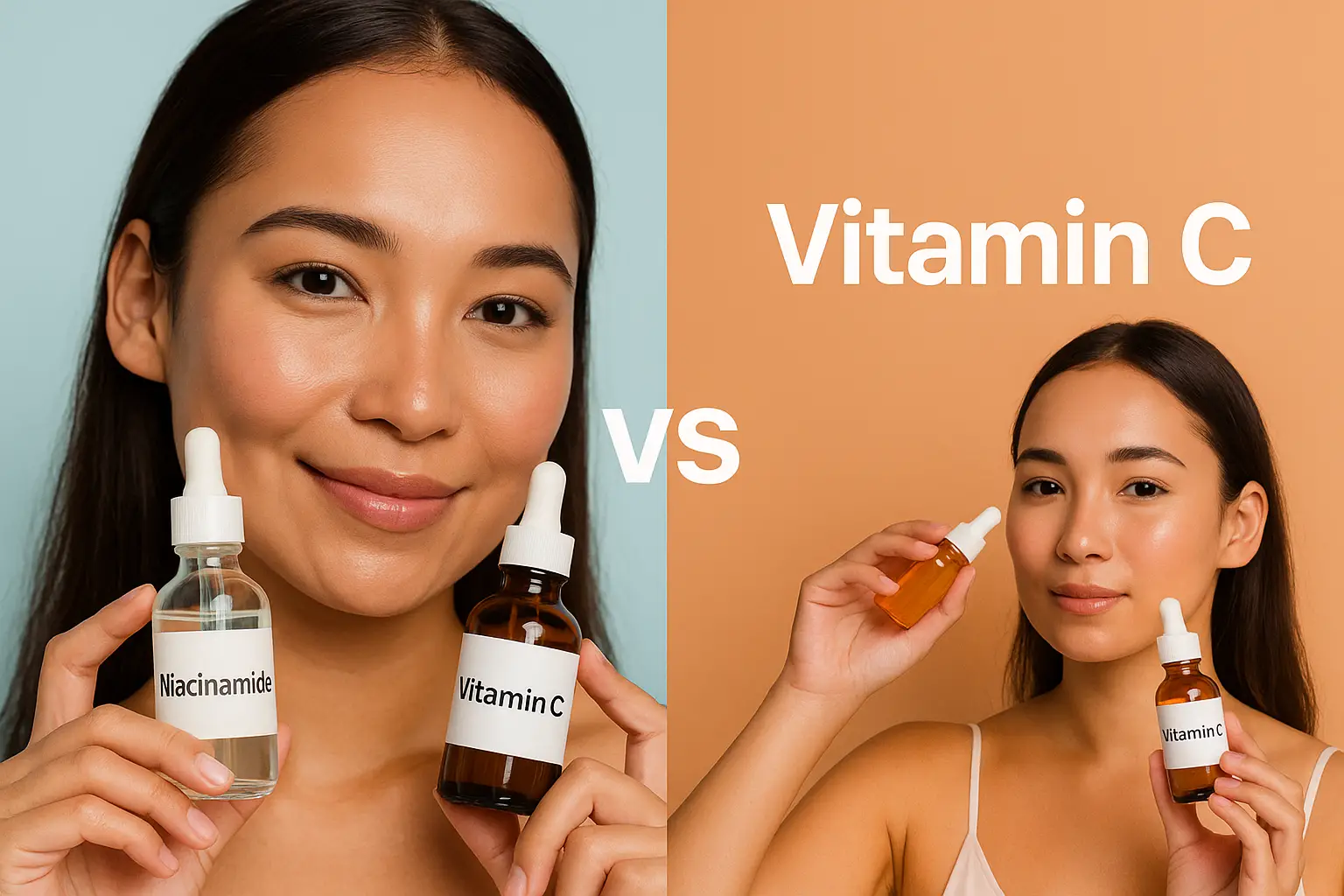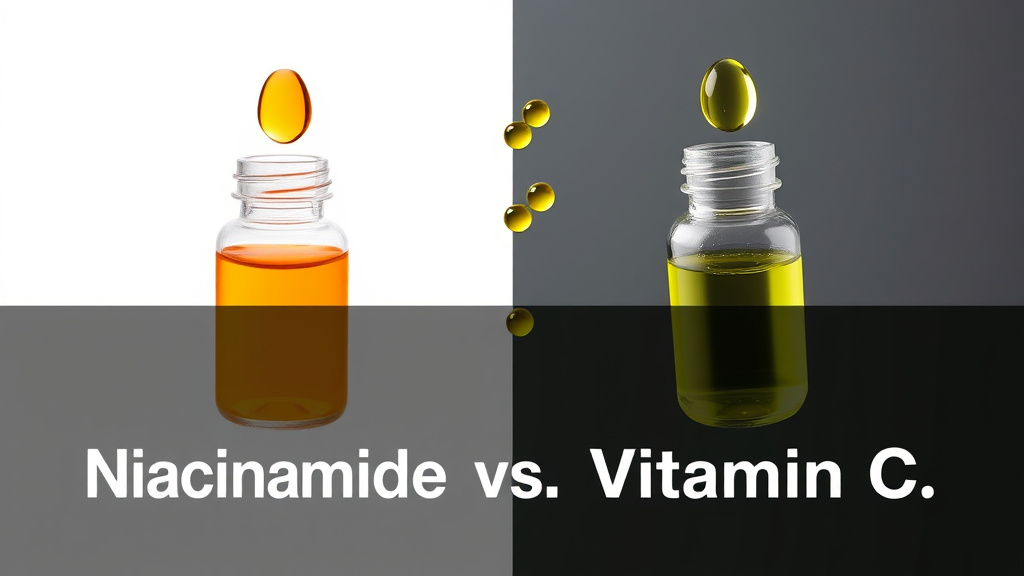When it comes to skincare ingredients, many people want to use top-rated antioxidants and active substances in their routines. Among these, Niacinamide vs Vitamin C is a popular comparison because both ingredients are celebrated for their skin-brightening, anti-aging, and protective qualities. This guide aims to clarify how these two powerhouse ingredients can be integrated into your routine safely and effectively, highlighting how to maximize their benefits while minimizing potential irritation.
Understanding how to layer niacinamide and vitamin C properly can help you craft a brightening skincare routine that supports your skin barrier and offers visible improvements. Because both ingredients are frequently found in serums, applying them in the right order and combination is essential to avoid counteracting effects such as irritation or reduced efficacy. Keep reading to learn the nuances involved in skincare ingredients comparison and recommendations for safe use.
Introduction: Why Ingredient Order Matters

When building a skincare routine, the sequence of applying active ingredients plays a crucial role in maximizing benefits and avoiding possible skin reactions. Not all skincare actives are compatible or should be layered one after another. For example, some ingredients like vitamin C (ascorbic acid) and niacinamide can be used together, but understanding the correct layering order ensures you don’t dilute their effects or cause irritation.
Proper ingredient layering not only enhances the effectiveness of your products but also maintains your skin barrier health. For instance, applying a gel-based serum like vitamin C before a niacinamide moisturizer may lead to better absorption. Conversely, some formulations or concentrations might require waiting periods or different applications to minimize pote
ntial irritation, especially if you have sensitive or compromised skin. This is why a clear understanding of skincare routine order is essential when combining these potent actives.
What is Niacinamide? (Benefits, How it Works)

Niacinamide (also known as vitamin B3) i
s a versatil
e, water-soluble vitamin that is well-loved for its wide-ranging skincare benefits. It is a calming and barrier-supporting ingredient, often recommended for oily, sensitive, or acne-prone skin. Niacinamide helps reinforce the skin’s natural protective barrier by stimulating ceramide production and reducing transepidermal water loss, which can help with moisture retention.
Its most notable benefits include improving the appearance of enlarged pores, reducing redness, and diminishing dark spots caused by hyperpigmentation or PIH (Post-Inflammatory Hyperpigmentation). Additionally, niacinamide may support the reduction of fine lines and uneven skin tone while helping to control excess oil production. Because it is generally well-tolerated, it’s an excellent inclusion in a brightening skincare routine aimed at skin clarity and barrier health.
What is Vitamin C? (Benefits, Stability, Forms)
Vitamin C (ascorbic acid) is a powerful antioxidant that is highly regarded for its ability to neutralize free radicals, brighten dull skin, and support collagen synthesis. As an antioxidant, it helps protect the skin from environmental damage caused by pollution and UV rays, which can accelerate aging, hyperpigmentation, and wrinkling.
However, keeping vitamin C stable in formulations can be challenging because it oxidizes when exposed to air, light, or heat. That’s why most vitamin C serums are formulated carefully and often come in opaque or airtight bottles. Available forms include L-ascorbic acid, sodium ascorbyl phosphate, and magnesium ascorbyl phosphate, each with different stability and efficacy levels. For skincare, choosing a serum with a suitable pH (around 3-3.5 for L-ascorbic acid) ensures maximum effectiveness.
In terms of skin benefits, vitamin C can improve the appearance of hyperpigmentation, give the skin a dewy glow, and support skin’s resilience. When incorporated into a brightening skincare routine, it works harmoniously with other antioxidants, making it a cornerstone of brightening skincare.
Vitamin C is a powerful antioxidant that brightens skin and supports collagen production.
According to Harvard Health’s overview of Vitamin C benefits, this essential nutrient not only protects against free radicals but also plays a key role in skin repair and resilience.
Niacinamide vs Vitamin C: Similarities Differences
Niacinamide vs Vitamin C each bring unique strengths to your skincare routine, but they also share some overlapping benefits—particularly their roles in reducing pigmentation and supporting skin barrier health. Both ingredients have been shown to support brightening effects, but their mechanisms differ; niacinamide primarily strengthens the barrier, while vitamin C provides oxidative protection and collagen boost.
In terms of skincare ingredients comparison, they differ significantly in stability and pH requirements. Vitamin C typically requires an acidic environment for optimal efficacy, which can sometimes lead to irritation if used in high concentrations, especially for sensitive skin. Conversely, niacinamide is stable across a wide pH range and is gentle, making it suitable for sensitive skin types.
A common concern is whether these ingredients can be used together without diminishing each other’s effects. When used correctly, niacinamide vs vitamin C can complement each other—if layered properly—forming a potent duo against signs of aging, dullness, and hyperpigmentation. The key lies in understanding how to layer niacinamide and vitamin C effectively to harness their full potential without risking irritation or neutralizing benefits.
How to Layer Niacinamide and Vitamin C Together (Step-by-Step)
The question of how to layer niacinamide and vitamin C is common, especially because each has different ideal pH levels. The general consensus for best results involves applying these actives in a way that preserves their stability and efficacy. First, cleanse your skin thoroughly, then follow these steps:
- Start with a gentle cleanser suitable for your skin type. For oily or acne-prone skin, a gel cleanser helps prep the skin by removing excess oil and debris, creating a clean canvas.
- Apply vitamin C serum first (preferably a L-ascorbic acid formulation with a pH around 3.5). This allows the antioxidant to penetrate effectively and provide maximum protection against environmental stressors.
- After the vitamin C serum has absorbed (wait for about 1–2 minutes), you can apply niacinamide. It can be layered directly on top or, if you prefer, wait a few minutes to minimize mixing issues.
- Follow with a moisturizer to lock in hydration. If you have sensitive skin, choosing a barrier-boosting moisturizer containing ceramides can support your skin’s health.
- Finish with sunscreen in the morning routines, as vitamin C increases photosensitivity. Reapplication of SPF during the day is essential, especially if your vitamin C serum is lightweight or water-based.
This method ensures that active ingredients do not compete or interfere with each other. This layering approach exemplifies best practices for antioxidant serums, optimizing benefits while reducing irritation risk.
After cleansing, apply Vitamin C serum first, followed by Niacinamide serum for maximum absorption.
If you want to see how these steps fit into a full regimen, explore our The Ultimate Beginner-Safe Skincare Routine Order (2025 Guide)
Common Mistakes When Combining Ingredients
Many users make familiar mistakes when combining niacinamide and vitamin C. One common error is applying both products simultaneously without considering their pH needs, which can reduce their efficiency. For example, applying a highly acidic vitamin C serum immediately before or after a niacinamide product can neutralize some benefits or cause temporary redness.
Another mistake involves overloading the skin with active ingredients, especially in sensitive skin types. Layering multiple acids, retinoids, and antioxidants at once without patch testing can lead to irritation or barrier damage. It’s important to introduce new actives gradually and observe how your skin responds.
Additionally, some users believe that niacinamide and vitamin C cannot be used together. As we’ve discussed, with proper layering and formulation selection, they can indeed complement each other well—making serum layering an art worth mastering in your routine.
FAQs
Q1: Can I use niacinamide and vitamin C at the same time? A: Yes, they can be used together if layered thoughtfully. Applying vitamin C first, followed by niacinamide, allows each to work optimally without neutralizing each other.
Q2: Will combining niacinamide and vitamin C cause irritation? A: Not if your skin tolerates each ingredient individually. Start with lower concentrations and monitor your skin for any signs of redness or discomfort.
Q3: Is it better to use niacinamide or vitamin C in the morning or night? A: Both can be used anytime, but vitamin C is especially beneficial in the morning to protect against environmental stressors. Niacinamide can be used morning or evening to support barrier health.
Q4: How long should I wait between applying vitamin C and niacinamide? A: Typically, waiting 1–2 minutes after applying vitamin C serum before layering niacinamide can facilitate maximum absorption and stability.
Conclusion
Niacinamide vs Vitamin C each offer distinct yet complementary benefits for your skin, whether you aim to brighten, protect, or repair. When used with an understanding of how to layer niacinamide and vitamin C, you can harness their full potential while safeguarding your skin barrier. Remember to introduce these ingredients gradually, use appropriate formulations, and apply them in the correct order—starting with vitamin C serum, waiting a moment, then applying niacinamide. This approach promotes a more effective and harmonious routine that supports skin health, clarity, and resilience. For tailored advice and detailed routines, explore our skincare routines hub. Elevate your skincare game with knowledge—your skin will thank you!
Not medical advice.
Want to learn more about layering skincare ingredients? Explore our full Skincare Ingredients Hub for expert guides and routines.




[…] Niacinamide vs Vitamin C: How to Use Them Together Safely (2025 Guide) […]